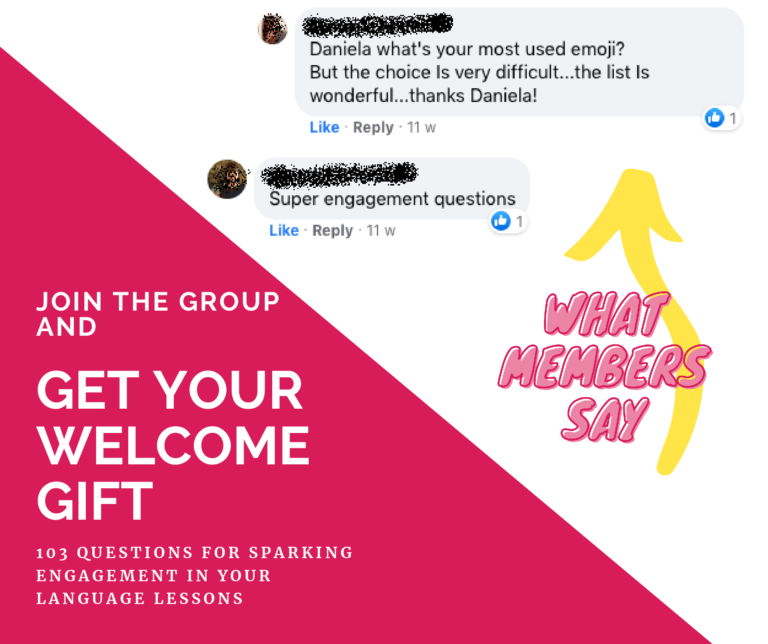
How much do learning styles have an impact in planning language lessons if you want to reach all your students? What are learning styles? And how do they relate to the different types of intelligences? In this article I will try to answer those questions and to draw conclusions that can be practically useful for the language teachers.
Before you dive in this article, take a moment to download the 12-score, smart check-list I use for reviewing all my lessons and courses to make sure I reach all my students:
What are learning styles?
Learning styles are our favourite way of learning, of approaching new things. We all have our preferred styles when it comes to learning. They have been classified and organised in models by a number of authors. The most widely-known author is David Kolb, who, back in 1984 published his Learning theory.
Which are Kolb’s 4 learning styles and what do they mean?
In his theory, Kolb says there is a processing continuum and a perception continuum. The processing continuum says how we like absorbing information: by doing rather than by watching. The perception continuum says if we prefer to experience/ feel rather than to think/ conceptualise.
We all have preferences and, when it comes to the way we prefer to approach tasks and the way we like experiencing learning (by thinking rather than by feeling), we make choices. Our choice relates to one variable from the Processing continuum we pick as a preferred variable and one preferred variable from the Perception continuum. The 2 preferred variables together make our preferred learning style.
As a consequence, in Kolb’s theory there are 4 learning styles:
- Diverger style
- Assimilator style
- Converger style
- Accommodator style
Those four learning styles are the output of the combination between the way we like getting involved in the learning process and take in information and the way we process new information and make sense of it.
4 learning styles, 4 types of learners
As a result, there are four types of learners:
- Type 1 (feel and watch) is the Diverger. Divergers like to take in information through concrete experiences and to make sense of it through their own observations and reflection. They prefer to experience practical activities and to rely on their own intuition to decide if the content is relevant to them. They usually need time for experiencing, elaborating and thinking things through before taking action with what you taught them.
- Type 2 (think and watch) is the Assimilator. Assimilators like to take in information through theoretical conceptualization and to make sense of it through their own observations and reflection. They like lectures and formal setting training. They usually rely on external information, data, case studies or the proved prestige of the teacher to decide if the new information is relevant to them. Because they need to think things through, just like type 1 learners, they need time before taking action with what you taught them.
- Type 3 (think and do) is the Converger. Convergers like to take in information through theoretical conceptualization and to make sense of it through concrete experiences and activities. They absorb the game rules and then they try to put them into use. That’s why they like playing around with the new information, testing it, experimenting and eventually they decide if the new content is relevant to them when they find it practical enough.
- Type 4 (feel and do) is the Accommodator. Accommodators like to take in information through concrete experiences and to make sense of it by “doing”, through concrete activities. They decide on the practical usefulness of what you taught them based on their own intuition. They don’t get on well with theoretical explanations, they prefer taking action and experimenting straightaway.
Learning styles and lesson planning: how do the learning styles affect my lessons?
How does this have an impact when you prepare a lesson for your students? Are you supposed to plan your lessons according to all your students’ different learning styles? Does that mean you are supposed to repurpose each lesson for reaching each learning style?
Before you definitely surrender to the frustration, allow me to reassure you and to tell you the truth about learning styles.
The truth is: planning an effective lesson is much simpler than that. It ought to be simpler, at least, and headache-free!
The 3 golden truths about learning styles and language teaching
Let’s start over from 3, important considerations:
- Kolb’s learning styles model paces the learning cycle
- Learning styles are not intelligences
- Your own teaching style matters
Read on, below I’m explaining those 3 scores.
1. Kolb’s learning styles model paces the learning cycle
The 4 learning styles are based on the four-stage learning cycle. In fact, Kolb suggests when we learn we go through 4 stages: experience, reflection, conceptualisation, experimentation. In other words, in a language class, for instance:
- Experience: we experience a communicative situation (e.g. we take part in a simulation, we watch a video, we listen to a dialogue, we read a piece of text)
- Reflection: we think and make sense of it (e.g. we try to get the gist meaning intuitively)
- Conceptualisation: we draw conclusions, we classify the new vocabulary or we get to the grammar structures behind the communicative act we experienced earlier. Then, we try to put this into use.
- Experimentation: we put the new vocabulary or grammar structures into use by trying to make them ours. We change the context and we test the new input to see how it can be helpful for us.
All of us go through the 4 step learning cycle (through all the 4 stages). However, some people prefer to start from a stage rather than another. There is where the difference between different learning styles originates. That said, everyone goes through the whole cycle. Nobody skips stages when they learn! The starting point may be different for each of us. The path we follow, though, is always the same for everybody: it’s the learning cycle.
As a consequence, as language teachers we need to touch all 4 learning styles! How can we do that without feeling overwhelmed?
I put together a helpful 12-score check-list that I use for reviewing my own lesson plans and for checking them in to see if I got all styles covered:
Remember to stick with the Acquisition Unit and Didactic Unit frameworks when you plan your lessons and to go for the inductive approach. All you can find on the check-list will help you to double check your lesson plans and to make sure you touched all learning styles.
2. Learning styles are not intelligences
Learning styles are NOT multiple intelligences. Nor Learning styles help to develop multiple intelligence. To put it plain: your students won’t become music genius if you play music during your classes.
For your reference, the 8 multiple intelligences model by Howard Gardner are: Linguistic, Logical/Mathematical, Spatial, Bodily-Kinesthetic, Musical, Interpersonal, Intrapersonal, and Naturalist. Later, Goleman added a 9th intelligence, the emotional intelligence.
In my experience, from the practical point of view of teaching, knowing about learning styles and multiple intelligences is not that enlightening and doesn’t affect the efficacy of your lessons that much. In fact, both if you run group courses and 1-to-1 lessons, in any case you will need to feed all learning styles in order to stimulate the learners through a variety of materials and methods.
3. Your own teaching style matters
It’s more important to know about your own teaching style rather than knowing about your students’ learning styles.
“Your training style appeals more to some learning styles than others.
When you apply your natural training strengths, you will likely find it easy to fulfil the needs of the learners who share your style preferences.
To become conscious of where you need to stretch to reach those learners who have different needs, [you need to] explore how your training style relates to the needs of each learning style.
Once you have identified learners you need to stretch to reach, you can begin to expand your toolkit of instructional design and delivery strategies to reach all learners.”
Jeanine O’Neill-Blackwell
In nutshell, my advice is to become aware of your teaching style preferences in order to know how to stretch and to diversify the way you offer input to your students. If you run one-on-one classes, the task is probably easier. If you run group classes, don’t get mad trying to match everyone’s style. Instead, empower your lessons plans by making sure you make the most out of all different tools and communicative channels: how do I reach students who like reflecting on the grammar? How do I reach students who like to practically experiment situations? How can I better serve students who like details?
Wrapping up
Knowing about the learning styles is helpful. However, knowing how to translate them into your teaching practice is gold! The practical tips I collected in the check-list, free for you to download (see box above), will help you to enrich your lessons so that you can make sure you reach all your students.
Also, you learnt learning styles are not intelligences. Your students won’t be developing their different types of intelligences because you diversify the activities in your classes.
Finally, it is far more important you become aware of your own teaching style to be able to stretch it, so that you reach everybody in your classrooms.
Want more support?
Join the Facebook group Independent Language Teachers Collective to get daily advice, tons of free training and to branch out with other independent language teachers like you!
ALSO…
Available only for the Collective members: free list 103 question for sparking engagement in your language lessons.
This is what members say about the freebie:

Join in the Collective and grab your welcome gift:


